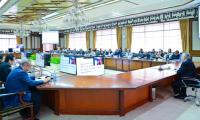LAHORE: According to World Bank findings, economies grow when more people find work, when they get better at what they do, and when they move from low-productivity work to better, more productive jobs. Does employment in Pakistan move this way?
World Bank’s new report “Pathways to better jobs in IDA countries” takes a closer look at how people benefit through jobs in the process of development.
It identifies how the available jobs change with economic transformation and shows how the structure of labour markets differs between low, lower-middle, and middle-income countries.
It points to key challenges in ensuring that workers can transition between sectors, between locations, and between self- and waged employment.
The first point that the report makes clear is that economic growth does not always bring enough good jobs. The GDP grows if accompanied with growth in labour productivity.
The quality of job increases with increase in labour productivity. If the increase in GDP growth is not accompanied with growth in labour productive then the number of new jobs may increase, but the quality of job (real wages) would deteriorate.
This is happening in Pakistan, where the wages continued increasing on state instructions without increasing the workers productivity. This is a sure recipe for poverty, as in low paid jobs the workers continue to live on the edge of poverty. They also fall back in poverty on every downturn in the economy, a frequent occurrence in Pakistan.
The state should provide incentive for improvement in workers’ productivity. After finding work, most workers obviously get better at what they do and ought to move from low productivity to higher productivity.
However, in Pakistan the concept of minimum wage is such that is a disincentive for increasing the workers’ productivity. Those employed 11 years back at Rs5,000/month are now getting Rs15,000/month (in Punjab at least) –courtesy Rs1,000 increase in minimum wage per year.
Now, a raw hand employed in 2019 also gets the same wage of Rs15,000 as the one with 11 years of experience.
The report also points out that underemployment, not unemployment, is the main challenge. This too is absolutely true and fits well in Pakistan’s case.
Officially, the unemployment rate in Pakistan varies from five to six percent. With such low unemployment rate, most families should be better off in Pakistan; it is not so because anyone that works even casually for five hours a week is considered employed in our country.
More than 50 percent of the employed workforce work fewer than 35 hours a week. Low-income countries with rapidly growing youthful populations need better jobs, not simply more of the same types of jobs. That requires growth with economic transformation into higher productivity work.
The report also states that structural transformation drives productivity growth. In order to conceal unemployment, the state statistics say that agriculture employees 42 percent of the workforce.
This workforce has to shift to industry and services to move ahead; as stagnation in agricultural productivity means that productivity of 42 percent labour force is not increasing.
The government should devise policies to raise agricultural productivity that will move the under employed labour out of agriculture. Urban centres should be developed as regional hubs of manufacturing and services.
A big increase in the share of wage jobs (both formal and informal) seems to coincide with the transformation from low income to middle income status.
The shares of agricultural workers, unpaid family workers, and self-employed workers decline in richer countries. This suggests that the creation of waged employment may be an important aspect of the economic transformation that countries make as they progress towards higher per capita income.







